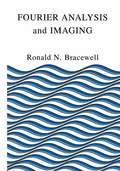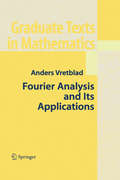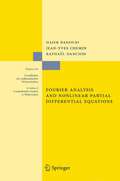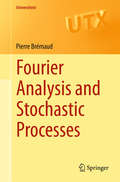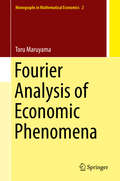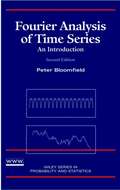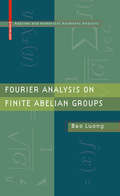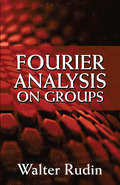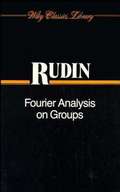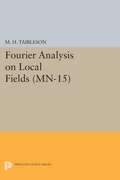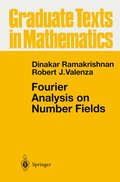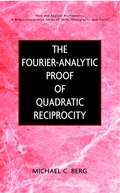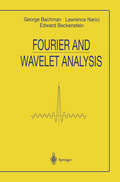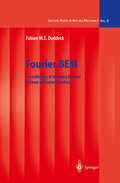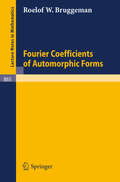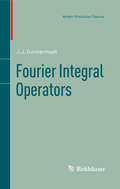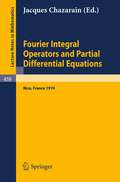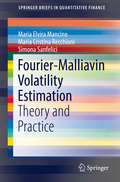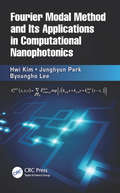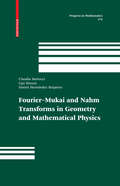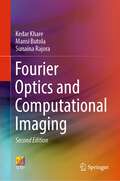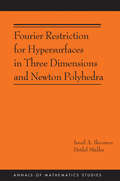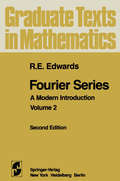- Table View
- List View
Fourier Analysis and Imaging
by Ronald BracewellAs Lord Kelvin said, "Fourier's theorem is not only one of the most beautiful results of modern analysis, but it may be said to furnish an indispensable instrument in the treatment of nearly every recondite question in modern physics." This has remained durable knowledge for a century, and has extended its applicability to topics as diverse as medical imaging (CT scanning), the presentation of images on screens and their digital transmission, remote sensing, geophysical exploration, and many branches of engineering. Fourier Analysis and Imaging is based on years of teaching a course on the Fourier Transform at the senior or early graduate level, as well as on Prof. Bracewell's 1995 text Two-Dimensional Imaging. It is an excellent textbook and will also be a welcome addition to the reference library of those many professionals whose daily activities involve Fourier analysis in its many guises.
Fourier Analysis and Its Applications (Graduate Texts in Mathematics #223)
by Anders VretbladA carefully prepared account of the basic ideas in Fourier analysis and its applications to the study of partial differential equations. The author succeeds to make his exposition accessible to readers with a limited background, for example, those not acquainted with the Lebesgue integral. Readers should be familiar with calculus, linear algebra, and complex numbers. At the same time, the author has managed to include discussions of more advanced topics such as the Gibbs phenomenon, distributions, Sturm-Liouville theory, Cesaro summability and multi-dimensional Fourier analysis, topics which one usually does not find in books at this level. A variety of worked examples and exercises will help the readers to apply their newly acquired knowledge.
Fourier Analysis and Nonlinear Partial Differential Equations (Grundlehren der mathematischen Wissenschaften #343)
by Hajer Bahouri Jean-Yves Chemin Raphaël DanchinIn recent years, the Fourier analysis methods have expereinced a growing interest in the study of partial differential equations. In particular, those techniques based on the Littlewood-Paley decomposition have proved to be very efficient for the study of evolution equations. The present book aims at presenting self-contained, state- of- the- art models of those techniques with applications to different classes of partial differential equations: transport, heat, wave and Schrödinger equations. It also offers more sophisticated models originating from fluid mechanics (in particular the incompressible and compressible Navier-Stokes equations) or general relativity. It is either directed to anyone with a good undergraduate level of knowledge in analysis or useful for experts who are eager to know the benefit that one might gain from Fourier analysis when dealing with nonlinear partial differential equations.
Fourier Analysis and Stochastic Processes (Universitext)
by Pierre BrémaudThis work is unique as it provides a uniform treatment of the Fourier theories of functions (Fourier transforms and series, z-transforms), finite measures (characteristic functions, convergence in distribution), and stochastic processes (including arma series and point processes).It emphasises the links between these three themes. The chapter on the Fourier theory of point processes and signals structured by point processes is a novel addition to the literature on Fourier analysis of stochastic processes. It also connects the theory with recent lines of research such as biological spike signals and ultrawide-band communications.Although the treatment is mathematically rigorous, the convivial style makes the book accessible to a large audience. In particular, it will be interesting to anyone working in electrical engineering and communications, biology (point process signals) and econometrics (arma models). Each chapter has an exercise section, which makes Fourier Analysis and Stochastic Processes suitable for a graduate course in applied mathematics, as well as for self-study.
Fourier Analysis of Economic Phenomena (Monographs in Mathematical Economics #2)
by Toru MaruyamaThis is the first monograph that discusses in detail the interactions between Fourier analysis and dynamic economic theories, in particular, business cycles.Many economic theories have analyzed cyclical behaviors of economic variables. In this book, the focus is on a couple of trials: (1) the Kaldor theory and (2) the Slutsky effect. The Kaldor theory tries to explain business fluctuations in terms of nonlinear, 2nd-order ordinary differential equations (ODEs). In order to explain periodic behaviors of a solution, the Hopf-bifurcation theorem frequently plays a key role. Slutsky's idea is to look at the periodic movement as an overlapping effect of random shocks. The Slutsky process is a weakly stationary process, the periodic (or almost periodic) behavior of which can be analyzed by the Bochner theorem. The goal of this book is to give a comprehensive and rigorous justification of these ideas. Therefore, the aim is first to give a complete theory that supports the Hopf theorem and to prove the existence of periodic solutions of ODEs; and second to explain the mathematical structure of the Bochner theorem and its relation to periodic (or almost periodic) behaviors of weakly stationary processes.Although these two targets are the principal ones, a large number of results from Fourier analysis must be prepared in order to reach these goals. The basic concepts and results from classical as well as generalized Fourier analysis are provided in a systematic way.Prospective readers are assumed to have sufficient knowledge of real, complex analysis. However, necessary economic concepts are explained in the text, making this book accessible even to readers without a background in economics.
Fourier Analysis of Time Series: An Introduction
by Peter BloomfieldA new, revised edition of a yet unrivaled work on frequency domain analysis Long recognized for his unique focus on frequency domain methods for the analysis of time series data as well as for his applied, easy-to-understand approach, Peter Bloomfield brings his well-known 1976 work thoroughly up to date. With a minimum of mathematics and an engaging, highly rewarding style, Bloomfield provides in-depth discussions of harmonic regression, harmonic analysis, complex demodulation, and spectrum analysis. All methods are clearly illustrated using examples of specific data sets, while ample exercises acquaint readers with Fourier analysis and its applications. The Second Edition: * Devotes an entire chapter to complex demodulation * Treats harmonic regression in two separate chapters * Features a more succinct discussion of the fast Fourier transform * Uses S-PLUS commands (replacing FORTRAN) to accommodate programming needs and graphic flexibility * Includes Web addresses for all time series data used in the examples An invaluable reference for statisticians seeking to expand their understanding of frequency domain methods, Fourier Analysis of Time Series, Second Edition also provides easy access to sophisticated statistical tools for scientists and professionals in such areas as atmospheric science, oceanography, climatology, and biology.
Fourier Analysis on Finite Abelian Groups (Applied and Numerical Harmonic Analysis)
by Bao LuongThis unified, self-contained book examines the mathematical tools used for decomposing and analyzing functions, specifically, the application of the [discrete] Fourier transform to finite Abelian groups. With countless examples and unique exercise sets at the end of each section, Fourier Analysis on Finite Abelian Groups is a perfect companion to a first course in Fourier analysis. This text introduces mathematics students to subjects that are within their reach, but it also has powerful applications that may appeal to advanced researchers and mathematicians. The only prerequisites necessary are group theory, linear algebra, and complex analysis.
Fourier Analysis on Groups (Dover Books on Mathematics)
by Walter RudinWritten by a master mathematical expositor, this classic text reflects the results of the intense period of research and development in the area of Fourier analysis in the decade preceding its first publication in 1962. The enduringly relevant treatment is geared toward advanced undergraduate and graduate students and has served as a fundamental resource for more than five decades.The self-contained text opens with an overview of the basic theorems of Fourier analysis and the structure of locally compact Abelian groups. Subsequent chapters explore idempotent measures, homomorphisms of group algebras, measures and Fourier transforms on thin sets, functions of Fourier transforms, closed ideals in L1(G), Fourier analysis on ordered groups, and closed subalgebras of L1(G). Helpful Appendixes contain background information on topology and topological groups, Banach spaces and algebras, and measure theory.
Fourier Analysis on Groups
by Walter RudinIn the late 1950s, many of the more refined aspects of Fourier analysis were transferred from their original settings (the unit circle, the integers, the real line) to arbitrary locally compact abelian (LCA) groups. Rudin's book, published in 1962, was the first to give a systematic account of these developments and has come to be regarded as a classic in the field. The basic facts concerning Fourier analysis and the structure of LCA groups are proved in the opening chapters, in order to make the treatment relatively self-contained.
Fourier Analysis on Local Fields. (MN-15)
by M. H. TaiblesonThis book presents a development of the basic facts about harmonic analysis on local fields and the n-dimensional vector spaces over these fields. It focuses almost exclusively on the analogy between the local field and Euclidean cases, with respect to the form of statements, the manner of proof, and the variety of applications.The force of the analogy between the local field and Euclidean cases rests in the relationship of the field structures that underlie the respective cases. A complete classification of locally compact, non-discrete fields gives us two examples of connected fields (real and complex numbers); the rest are local fields (p-adic numbers, p-series fields, and their algebraic extensions). The local fields are studied in an effort to extend knowledge of the reals and complexes as locally compact fields.The author's central aim has been to present the basic facts of Fourier analysis on local fields in an accessible form and in the same spirit as in Zygmund's Trigonometric Series (Cambridge, 1968) and in Introduction to Fourier Analysis on Euclidean Spaces by Stein and Weiss (1971).Originally published in 1975.The Princeton Legacy Library uses the latest print-on-demand technology to again make available previously out-of-print books from the distinguished backlist of Princeton University Press. These editions preserve the original texts of these important books while presenting them in durable paperback and hardcover editions. The goal of the Princeton Legacy Library is to vastly increase access to the rich scholarly heritage found in the thousands of books published by Princeton University Press since its founding in 1905.
Fourier Analysis on Number Fields (Graduate Texts in Mathematics #186)
by Dinakar Ramakrishnan Robert J. ValenzaA modern approach to number theory through a blending of complementary algebraic and analytic perspectives, emphasising harmonic analysis on topological groups. The main goal is to cover John Tates visionary thesis, giving virtually all of the necessary analytic details and topological preliminaries -- technical prerequisites that are often foreign to the typical, more algebraically inclined number theorist. While most of the existing treatments of Tates thesis are somewhat terse and less than complete, the intent here is to be more leisurely, more comprehensive, and more comprehensible. While the choice of objects and methods is naturally guided by specific mathematical goals, the approach is by no means narrow. In fact, the subject matter at hand is germane not only to budding number theorists, but also to students of harmonic analysis or the representation theory of Lie groups. The text addresses students who have taken a year of graduate-level course in algebra, analysis, and topology. Moreover, the work will act as a good reference for working mathematicians interested in any of these fields.
The Fourier-Analytic Proof of Quadratic Reciprocity (Pure and Applied Mathematics: A Wiley Series of Texts, Monographs and Tracts #41)
by Michael C. BergA unique synthesis of the three existing Fourier-analytic treatments of quadratic reciprocity. The relative quadratic case was first settled by Hecke in 1923, then recast by Weil in 1964 into the language of unitary group representations. The analytic proof of the general n-th order case is still an open problem today, going back to the end of Hecke's famous treatise of 1923. The Fourier-Analytic Proof of Quadratic Reciprocity provides number theorists interested in analytic methods applied to reciprocity laws with a unique opportunity to explore the works of Hecke, Weil, and Kubota. This work brings together for the first time in a single volume the three existing formulations of the Fourier-analytic proof of quadratic reciprocity. It shows how Weil's groundbreaking representation-theoretic treatment is in fact equivalent to Hecke's classical approach, then goes a step further, presenting Kubota's algebraic reformulation of the Hecke-Weil proof. Extensive commutative diagrams for comparing the Weil and Kubota architectures are also featured. The author clearly demonstrates the value of the analytic approach, incorporating some of the most powerful tools of modern number theory, including adèles, metaplectric groups, and representations. Finally, he points out that the critical common factor among the three proofs is Poisson summation, whose generalization may ultimately provide the resolution for Hecke's open problem.
Fourier and Wavelet Analysis (Universitext)
by George Bachmann Lawrence Narici EDWARD BECKENSTEINThis comprehensive volume develops all of the standard features of Fourier analysis - Fourier series, Fourier transform, Fourier sine and cosine transforms, and wavelets. The books approach emphasizes the role of the "selector" functions, and is not embedded in the usual engineering context, which makes the material more accessible to a wider audience. While there are several publications on the various individual topics, none combine or even include all of the above.
Fourier BEM: Generalization of Boundary Element Methods by Fourier Transform (Lecture Notes in Applied and Computational Mechanics #5)
by Fabian M.E. DuddeckLike FEM, the Boundary Element Method (BEM) provides a general numerical tool for the solution of complex engineering problems. In the last decades, the range of its applications has remarkably been enlarged. Therefore dynamic and nonlinear problems can be tackled. However they still demand an explicit expression of a fundamental solution, which is only known in simple cases. In this respect, the present book proposes an alternative BEM-formulation based on the Fourier transform, which can be applied to almost all cases relevant in engineering mechanics. The basic principle is presented for the heat equation. Applications are taken from solid mechanics (e.g. poroelasticity, thermoelasticity). Transient and stationary examples are given as well as linear and nonlinear. Completed with a mathematical and mechanical glossary, the book will serve as a comprehensive text book linking applied mathematics to real world engineering problems.
Fourier Integral Operators (Modern Birkhäuser Classics Ser.)
by J.J. DuistermaatThis volume is a useful introduction to the subject of Fourier Integral Operators and is based on the author’s classic set of notes. Covering a range of topics from Hörmander’s exposition of the theory, Duistermaat approaches the subject from symplectic geometry and includes application to hyperbolic equations (= equations of wave type) and oscillatory asymptotic solutions which may have caustics. This text is suitable for mathematicians and (theoretical) physicists with an interest in (linear) partial differential equations, especially in wave propagation, rep. WKB-methods.
Fourier Integral Operators and Partial Differential Equations: Colloque International, Universite de Nice, 1974 (Lecture Notes in Mathematics #459)
by J. ChazarainFourier-Malliavin Volatility Estimation: Theory and Practice (SpringerBriefs in Quantitative Finance)
by Maria Elvira Mancino Maria Cristina Recchioni Simona SanfeliciThis volume is a user-friendly presentation of the main theoretical properties of the Fourier-Malliavin volatility estimation, allowing the readers to experience the potential of the approach and its application in various financial settings. Readers are given examples and instruments to implement this methodology in various financial settings and applications of real-life data. A detailed bibliographic reference is included to permit an in-depth study.
Fourier Modal Method and Its Applications in Computational Nanophotonics
by Hwi Kim Junghyun Park Byoungho LeeMost available books on computational electrodynamics are focused on FDTD, FEM, or other specific technique developed in microwave engineering. In contrast, Fourier Modal Method and Its Applications in Computational Nanophotonics is a complete guide to the principles and detailed mathematics of the up-to-date Fourier modal method of optical analysis. It takes readers through the implementation of MATLAB® codes for practical modeling of well-known and promising nanophotonic structures. The authors also address the limitations of the Fourier modal method.Features Provides a comprehensive guide to the principles, methods, and mathematics of the Fourier modal method Explores the emerging field of computational nanophotonics Presents clear, step-by-step, practical explanations on how to use the Fourier modal method for photonics and nanophotonics applications Includes the necessary MATLAB codes, enabling readers to construct their own code Using this book, graduate students and researchers can learn about nanophotonics simulations through a comprehensive treatment of the mathematics underlying the Fourier modal method and examples of practical problems solved with MATLAB codes.
Fourier Modal Method and Its Applications in Computational Nanophotonics
by Hwi Kim Junghyun Park Byoungho LeeMost available books on computational electrodynamics are focused on FDTD, FEM, or other specific technique developed in microwave engineering. In contrast, Fourier Modal Method and Its Applications in Computational Nanophotonics is a complete guide to the principles and detailed mathematics of the up-to-date Fourier modal method of optical analysis. It takes readers through the implementation of MATLAB® codes for practical modeling of well-known and promising nanophotonic structures. The authors also address the limitations of the Fourier modal method.Features Provides a comprehensive guide to the principles, methods, and mathematics of the Fourier modal method Explores the emerging field of computational nanophotonics Presents clear, step-by-step, practical explanations on how to use the Fourier modal method for photonics and nanophotonics applications Includes the necessary MATLAB codes, enabling readers to construct their own code Using this book, graduate students and researchers can learn about nanophotonics simulations through a comprehensive treatment of the mathematics underlying the Fourier modal method and examples of practical problems solved with MATLAB codes.
Fourier-Mukai and Nahm Transforms in Geometry and Mathematical Physics (Progress in Mathematics #276)
by CLAUDIO BARTOCCI Ugo Bruzzo Daniel Hernández RuipérezIntegral transforms, such as the Laplace and Fourier transforms, have been major tools in mathematics for at least two centuries. In the last three decades the development of a number of novel ideas in algebraic geometry, category theory, gauge theory, and string theory has been closely related to generalizations of integral transforms of a more geometric character. "Fourier–Mukai and Nahm Transforms in Geometry and Mathematical Physics" examines the algebro-geometric approach (Fourier–Mukai functors) as well as the differential-geometric constructions (Nahm). Also included is a considerable amount of material from existing literature which has not been systematically organized into a monograph. Key features: Basic constructions and definitions are presented in preliminary background chapters - Presentation explores applications and suggests several open questions - Extensive bibliography and index. This self-contained monograph provides an introduction to current research in geometry and mathematical physics and is intended for graduate students and researchers just entering this field.
Fourier Optics and Computational Imaging
by Kedar Khare Mansi Butola Sunaina RajoraThe book is designed to serve as a textbook for advanced undergraduate and graduate students enrolled in physics and electronics and communication engineering and mathematics. The book provides an introduction to Fourier optics in light of new developments in the area of computational imaging over the last couple of decades. There is an in-depth discussion of mathematical methods such as Fourier analysis, linear systems theory, random processes, and optimization-based image reconstruction techniques. These techniques are very much essential for a better understanding of the working of computational imaging systems. It discusses topics in Fourier optics, e.g., diffraction phenomena, coherent and incoherent imaging systems, and some aspects of coherence theory. These concepts are then used to describe several system ideas that combine optical hardware design and image reconstruction algorithms, such as digital holography, iterative phase retrieval, super-resolution imaging, point spread function engineering for enhanced depth-of-focus, projection-based imaging, single-pixel or ghost imaging, etc. The topics covered in this book can provide an elementary introduction to the exciting area of computational imaging for students who may wish to work with imaging systems in their future careers.
Fourier Restriction for Hypersurfaces in Three Dimensions and Newton Polyhedra (AM-194)
by Isroil A. Ikromov Detlef MüllerThis is the first book to present a complete characterization of Stein-Tomas type Fourier restriction estimates for large classes of smooth hypersurfaces in three dimensions, including all real-analytic hypersurfaces. The range of Lebesgue spaces for which these estimates are valid is described in terms of Newton polyhedra associated to the given surface.Isroil Ikromov and Detlef Müller begin with Elias M. Stein's concept of Fourier restriction and some relations between the decay of the Fourier transform of the surface measure and Stein-Tomas type restriction estimates. Varchenko's ideas relating Fourier decay to associated Newton polyhedra are briefly explained, particularly the concept of adapted coordinates and the notion of height. It turns out that these classical tools essentially suffice already to treat the case where there exist linear adapted coordinates, and thus Ikromov and Müller concentrate on the remaining case. Here the notion of r-height is introduced, which proves to be the right new concept. They then describe decomposition techniques and related stopping time algorithms that allow to partition the given surface into various pieces, which can eventually be handled by means of oscillatory integral estimates. Different interpolation techniques are presented and used, from complex to more recent real methods by Bak and Seeger.Fourier restriction plays an important role in several fields, in particular in real and harmonic analysis, number theory, and PDEs. This book will interest graduate students and researchers working in such fields.
Fourier Restriction for Hypersurfaces in Three Dimensions and Newton Polyhedra (AM-194)
by Isroil A. Ikromov Detlef MüllerThis is the first book to present a complete characterization of Stein-Tomas type Fourier restriction estimates for large classes of smooth hypersurfaces in three dimensions, including all real-analytic hypersurfaces. The range of Lebesgue spaces for which these estimates are valid is described in terms of Newton polyhedra associated to the given surface.Isroil Ikromov and Detlef Müller begin with Elias M. Stein's concept of Fourier restriction and some relations between the decay of the Fourier transform of the surface measure and Stein-Tomas type restriction estimates. Varchenko's ideas relating Fourier decay to associated Newton polyhedra are briefly explained, particularly the concept of adapted coordinates and the notion of height. It turns out that these classical tools essentially suffice already to treat the case where there exist linear adapted coordinates, and thus Ikromov and Müller concentrate on the remaining case. Here the notion of r-height is introduced, which proves to be the right new concept. They then describe decomposition techniques and related stopping time algorithms that allow to partition the given surface into various pieces, which can eventually be handled by means of oscillatory integral estimates. Different interpolation techniques are presented and used, from complex to more recent real methods by Bak and Seeger.Fourier restriction plays an important role in several fields, in particular in real and harmonic analysis, number theory, and PDEs. This book will interest graduate students and researchers working in such fields.
Fourier Series: A Modern Introduction Volume 2 (Graduate Texts in Mathematics #85)
by R. E. Edwardsappear in Volume 1, a Roman numeral "I" has been prefixed as a reminder to the reader; thus, for example, "I,B.2.1 " refers to Appendix B.2.1 in Volume 1. An understanding of the main topics discussed in this book does not, I hope, hinge upon repeated consultation of the items listed in the bibli ography. Readers with a limited aim should find strictly necessary only an occasional reference to a few of the book listed. The remaining items, and especially the numerous research papers mentioned, are listed as an aid to those readers who wish to pursue the subject beyond the limits reached in this book; such readers must be prepared to make the very considerable effort called for in making an acquaintance with current research literature. A few of the research papers listed cover devel opments that came to my notice too late for mention in the main text. For this reason, any attempted summary in the main text of the current standing of a research problem should be supplemented by an examin ation of the bibliography and by scrutiny of the usual review literature.
